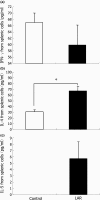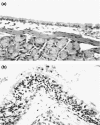Acute urticaria[corrected]-like lesions in allergen-unexposed cutaneous tissues in a mouse model of late allergic rhinitis
- PMID: 18460071
- PMCID: PMC2525774
- DOI: 10.1111/j.1365-2613.2008.00577.x
Acute urticaria[corrected]-like lesions in allergen-unexposed cutaneous tissues in a mouse model of late allergic rhinitis
Erratum in
- Int J Exp Pathol. 2008 Aug;89(4):301
Abstract
The mechanisms of distant manifestation after a local allergic reaction are largely unknown. This study examined the development of cutaneous lesions in a mouse model of late allergic rhinitis (LAR). BALB/c mice were sensitized by ovalbumin (OVA) intraperitoneally two times (on days 0 and 10) and challenged by OVA intranasally on day 14. Four days after OVA challenge, nasal and cutaneous lesions including helper T (Th) responses, expression of adhesion molecules and presence of OVA and IgE were examined, and compared with unsensitized and unchallenged (control) mice. Compared with the control group, the LAR group developed LAR characterized by infiltration of lymphocytes and eosinophils, increased IgE values and increased productions of IL-4 and IL-5, but not IFN-gamma. A dominant infiltration of eosinophils and increase in mast cells, attachment of eosinophils to endothelium, intense expression of VCAM-1 on endothelium in venules and VLA-4 expression on eosinophils and mast cells were recognized in the cutaneous tissues. There were no differences in the expression of ICAM-1 on vascular endothelium and LFA-1 on infiltrated leucocytes between the two groups. CLA expression on lymphocytes was not detected, and the binding of OVA and IgE on mast cells and eosinophils was found in the cutaneous lesions in the LAR group, but not in the control group. This study suggests that acute urticaria[corrected]-like lesions in OVA-unexposed cutaneous tissues may be induced by immediate allergic reaction due to the systemic development of Th2-type response in a mouse model of LAR.
Figures








References
-
- Beyer K, Castro R, Feidel C, Feidel C, Sampson HA. Milk-induced urticaria is associated with the expansion of T cells expressing cutaneous lymphocyte antigen. J. Allergy Clin. Immunol. 2002;109:688–693. - PubMed
-
- Brinkman L, Aslander MM, Raaijmakersb JA, Lammers JW, Koenderman L, Bruijnzeel-Koomen CA. Bronchial and cutaneous responses in atopic dermatitis patients after allergen inhalation challenge. Clin. Exp. Allergy. 1997;27:1043–1051. - PubMed
-
- Burks AW, Mallory SB, Williams LW, Shirrell MA. Atopic dermatitis: clinical relevance of food hypersensitivity reactions. J. Pediatr. 1998;113:447–451. - PubMed
-
- Cotran RS, Pober JS. Effects of cytokines on vascular endothelium: their role in vascular and immune injury. Kidney Int. 1989;35:969–975. - PubMed
-
- Franson M, Benson M, Wennergren G, Gardell LO. A role for neutrophils in intermittent allergic rhinitis. Acta Otolaryngol. 2004;124:616–620. - PubMed
Publication types
MeSH terms
Substances
LinkOut - more resources
Full Text Sources
Medical
Miscellaneous

